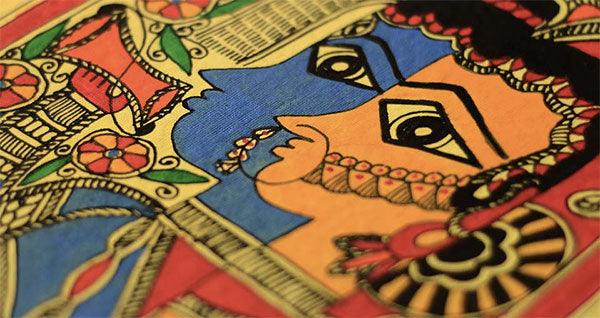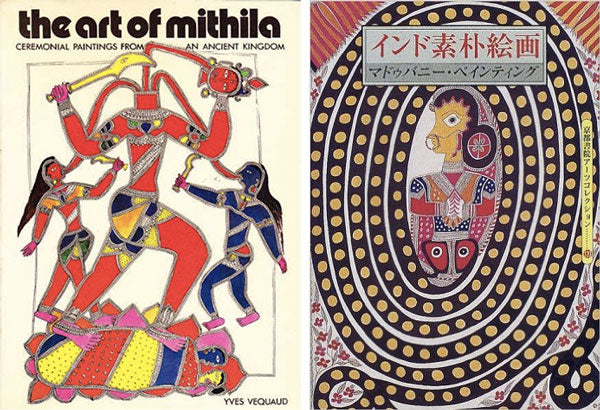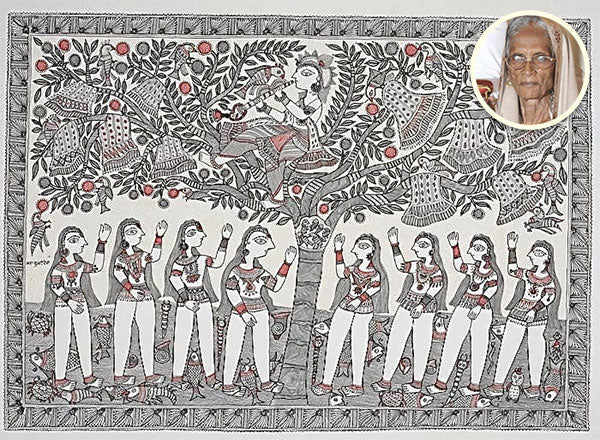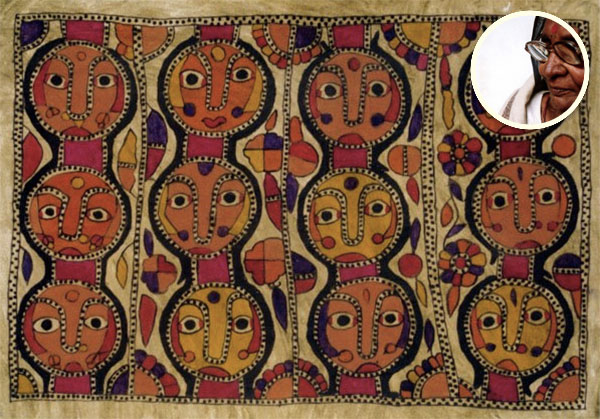
The Art of Madhubani #HandmadeInIndia
Share
Madhubani painting or Mithila painting is a style of art practiced in the Mithila region of Nepal and in Bihar in India. Madhubani paintings are created using fingers, twigs, brushes, nib-pens, and matchsticks, using natural dyes and pigments and characterized by eye-catching geometrical patterns. Madhubani paintings are usually about occasions and festival such as birth, marriage, Holi, Surya Shasti, Kali Puja, Upanayanam, Durga Puja, and other important days in the Hindu calendar and culture. The Mithila region, from which the name Mithila art is derived, is believed to have been the kingdom of King Janak, a name readers of the Ramayana may be familiar with. The exact location of it lies in present-day Janakpur of Nepal.

Time and place of Madhubani Art
The exact time when Mithila art originated is not known. According to local mythology, it all began around the time of Ramayana, when King Janaka of Nepal ordered his kingdom to decorate the town to commemorate and celebrate his daughter Sita’s wedding to Lord Rama.

Dig a little deeper into the history of Madhubani art and you will discover that the ancient tradition of elaborate wall paintings or Bhitti-Chitra in Nepal and Bihar played a major role in the emergence of the Madhubani art form.
Furthermore, the original inspiration for Madhubani art emerged from the womenfolk’s craving for religiousness and an intense desire to be one with God. With the belief that painting something divine would achieve that desire, women began to paint pictures of gods and goddesses with an interpretation so divine that it captured the hearts of many.

Madhubani, which by one account means Forest of Honey, (‘Madhu’-honey, ‘Ban’-forest or woods) is a region in Mithila and a distinct identity and language that is believed to go back over 2500 years.
These paintings were traditionally created by the women of the Brahman, Dusadh, and Kayastha communities in Mithila region. The art form originated in Madhubani village of the capital city of Ancient Mithila, known as Janakpur and has remained confined to a compact geographical area, with the skills passed on through generations and centuries. Even the content and the style of this art form have largely remained the same. It is for these reasons that Madhubani painting has been accorded the coveted GI (Geographical Indication) status.
Madhubani Art – Castes of characters
Madhubani art has five distinctive styles, namely, Bharni, Katchni, Tantrik, Nepali, and Kohbar. In the 1960s Bharni, Kachni and Tantrik style were mainly done by Brahman and Kayashth women (considered upper-castes) in India and Nepal. Their themes were mainly religious, and they depicted Gods and Goddesses in their paintings.
On the other hand, people of lower castes and classes included aspects of their daily life in their paintings. The Godna and Kohbar styles, for instance, are the preserve of the Dalit and Dushadh communities. Kohbar paintings are usually made by a to-be bride's family as a present to a to-be groom's family.

A Kohbar-style Madhubani Painting showing aspects of daily life
Women drivers of Madhubani Art
The women painters of Mithila lived in a closed society. It is believed that the Madhubani painting tradition began when Raja Janak of Nepal commissioned local artists to paint murals in his palace in preparations for the marriage of his daughter Sita to Lord Ram. The paintings were originally done on walls coated with mud and cow dung. The kohbar ghar or the nuptial chamber was the room in which the paintings were traditionally done.

Originally the paintings depicted an assembly of symbolic images of the lotus plant, the bamboo grove, fishes, birds and snakes in union. These images represented fertility and proliferation of life. There used to be a tradition that the newly married bride and groom would spend three nights in the kohbar ghar without cohabiting. On the fourth night they would consummate the marriage surrounded with the colourful painting. The Mithila paintings were done only by women of the house, the village, and the caste, and only on occasion of marriages.
Madhubani Art – Going places
Mithila painting, as a domestic ritual activity, was unknown to the outside world until the massive India-Nepal border earthquake of 1934. The quake brought the houses tumbling down and the art out in the open.
The then British colonial officer in Madhubani District, William G. Archer, while inspecting the damage “discovered” the paintings on the newly exposed interior walls of the homes of Mithila and was struck by reported similarities to the work of modern Western artists like Miro and Picasso. He took black and white photos of some of these paintings, which today are the earliest images of the art. In addition, William G. Archer also wrote about the paintings in a 1949 article in ‘Marg’ an Indo-Nepal Art Journal. Thus began the spread of Madhubani Art.

Pioneering art historians and writers, William George Archer and his wife Mildred Agnes Bell
Years later, the drought from 1966 to 1968 crippled the agricultural economy of the region. As part of a larger initiative to bring economic relief to the stricken people, Ms. Pupul Jayakar, the then Director of the All Indo-Nepal Handicrafts Board, sent the Bombay-based artist Mr. Bhaskar Kulkarni to Mithila to encourage women there to replicate their mural paintings on paper in order to facilitate sales as a source of income to ensure survival.
The contribution of foreign scholars in promoting the art form internationally has also been immense. Yves Vequad, a French novelist and journalist, wrote a book in the early 1970s on the basis of his research on Mithila painting and produced a film ‘The Women Painters of Mithila’.

The German anthropologist film-maker and social activist Erika Moser persuaded the impoverished Dusadh community to paint. The result was the Dusadh captured their oral history (such as the adventures of Raja Salhesh, and depictions of their primary deity, Rahu) — typified by bold compositions and figures based on traditional tattoo patterns called Goidna locally. This added another distinctive new style to the region’s flourishing art scene.

Madhubani Wall Painting at the National Crafts Museum, Delhi (Picture Courtesy: Flickr)
With the financial support of Moser and Raymond Lee Owens (a Fulbright Scholar then), along with land in Jitwarpur donated by Anthropologist Erika Moser, the likes of Dr. Gauri Mishra spearheaded the setting up of the Master Craftsmen Association of Mithila in 1977. This association was very active during the life time of Owens and worked in tandem with Ethnic Arts Foundation of USA.
Even the Ford Foundation has a long history of association with Madhubani painting. Ms. Viji Srinivasan, then a programme officer with Ford Foundation, and who later set up an NGO Adithi headquartered in Bihar and worked on women’s issues including livelihood through handicrafts too played a role in nurturing the cluster.
Since the 1990s, Japan has also shown a keen interest in Madhubani paintings, mainly because of the initiatives of Tokyo Hasegawa, who set up the Mithila Museum in Tokamachi, where around 850 Madhubani paintings are exhibited on a regular basis. As a result of all these initiatives, Madhubani Art is well known all over the world today.
Stars of Madhubani Art
Madhubani painting received official recognition in 1975, when the President of India awarded the Padma Shri to Jagdamba Devi, of Jitwarpur village near Madhubani. This was just the beginning. In 1981 Sita Devi was awarded the Padma Shri. In 1990, Ganga Devi of Mithila was awarded the Padma Shri. Mahasundari Devi was awarded the Padma Shri in 2011. Furthermore, Baua Devi, Yamuna Devi, Shanti Devi, Chano Devi, Bindeshwari Devi , Chandrakala Devi, Shashikala Devi, Leela Devi, Godavari Dutta, Bharti Dayal, Chandrabhushan, Ambika Devi, Manisha Jha were also given National Awards.

Vegetal Colors on Paper depicting the Ram-Sita marriage- Jagadamba Devi (Padma Shri, 1975)

Kohbar/Nuptial Champar depiction by Legendary Artist Sita Devi (Padma Shri, 1981)

Ride in a Roller Coaster (1986) by Ganga Devi (Padma Shri, 1990)

Kohbar/Nuptial Champar depiction by Legendary Artist Mahasundari Devi (Padma Shri, 2011)

Depiction of the legend of Krishna by Baua Devi (National Award Winner, 1984)

The face (an allegory of the moon/sun) is a recurring subject in Yamuna Devi’s work. The distinctive double lines are inspired by the kohl applied around the eyes of newborn babies.
Yamuna Devi was the first untouchable among the Mithila women painters to receive a National Award.
Bharti Dayal - Flagbearer of the Current Generation of Madhubani Art
Bharti Dayal is a Madhubani artist and has played a significant role in the re-emergence and propagation of this art form. She is credited with contemporising the art form through the use of modern media (acrylic and canvas); and for bringing Madhubani art recognition within the world of fine art.

Mother Yasoda Feeding Little Krishna by Bharti Dayal
Smt Bharti Dayal won an Award from the All India Fine Arts and Crafts for fifty years of art in independent India and the state Award for kalamkari in Mithila Painting. Bharti Dayal’s painting "Eternal Music" bagged the top award at the Millennium Art Competition from AIFAC for the year 2001. Bharti Dayal was also honoured with The Vishist Bihari Samman amid festivities to commemorate 100 year of Bihar. She has been honoured with the Indira Gandhi Priyadarshini Award 2013 for her exceptional work in Madhubani Art, globally too.
The art of Madhubani on video
Madhubani Art is hard work. See how much and how to in this video.
And if you like what you see in the first video, you will find many more videos on the fine and divine art of Madhubani here.
Pinteresting stuff on Madhubani Art
Pinterest, with its emphasis on visual presentation is a great place to feast your eyes on the beauty of Madhubani Art. Here is a board that prove what a sight for sore eyes this ancient and intricate art is: Pinterest: Madhubani Board | Pinterest: More Search Results
Madhubani on Housenama
Here's a handpicked list of 4 name plates from the Housenama collection of Madhubani-inspired products.
|
|
|
|
|
|
Note: To browse through all the posts in the 'Handmade in India' series, click here.




